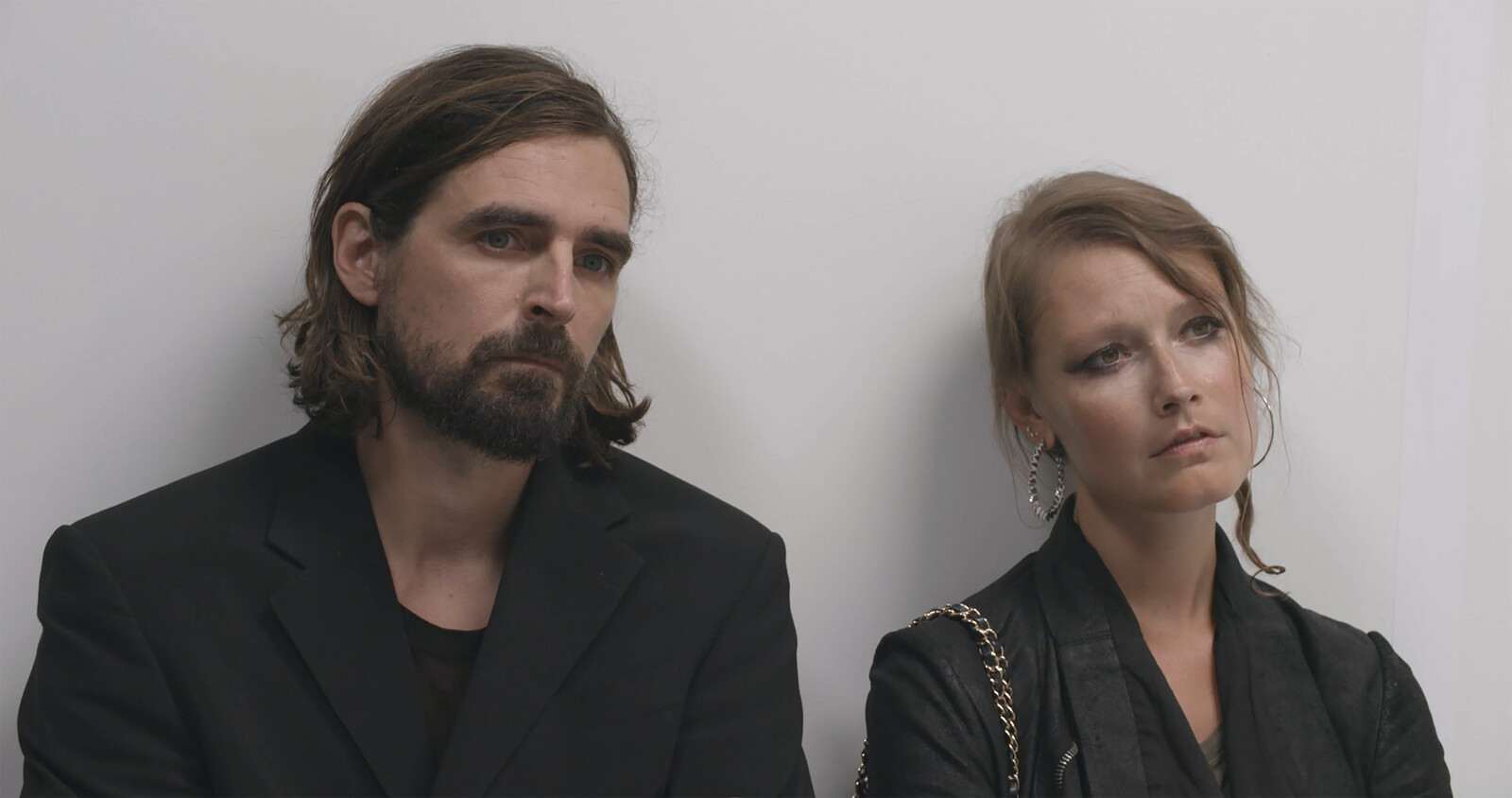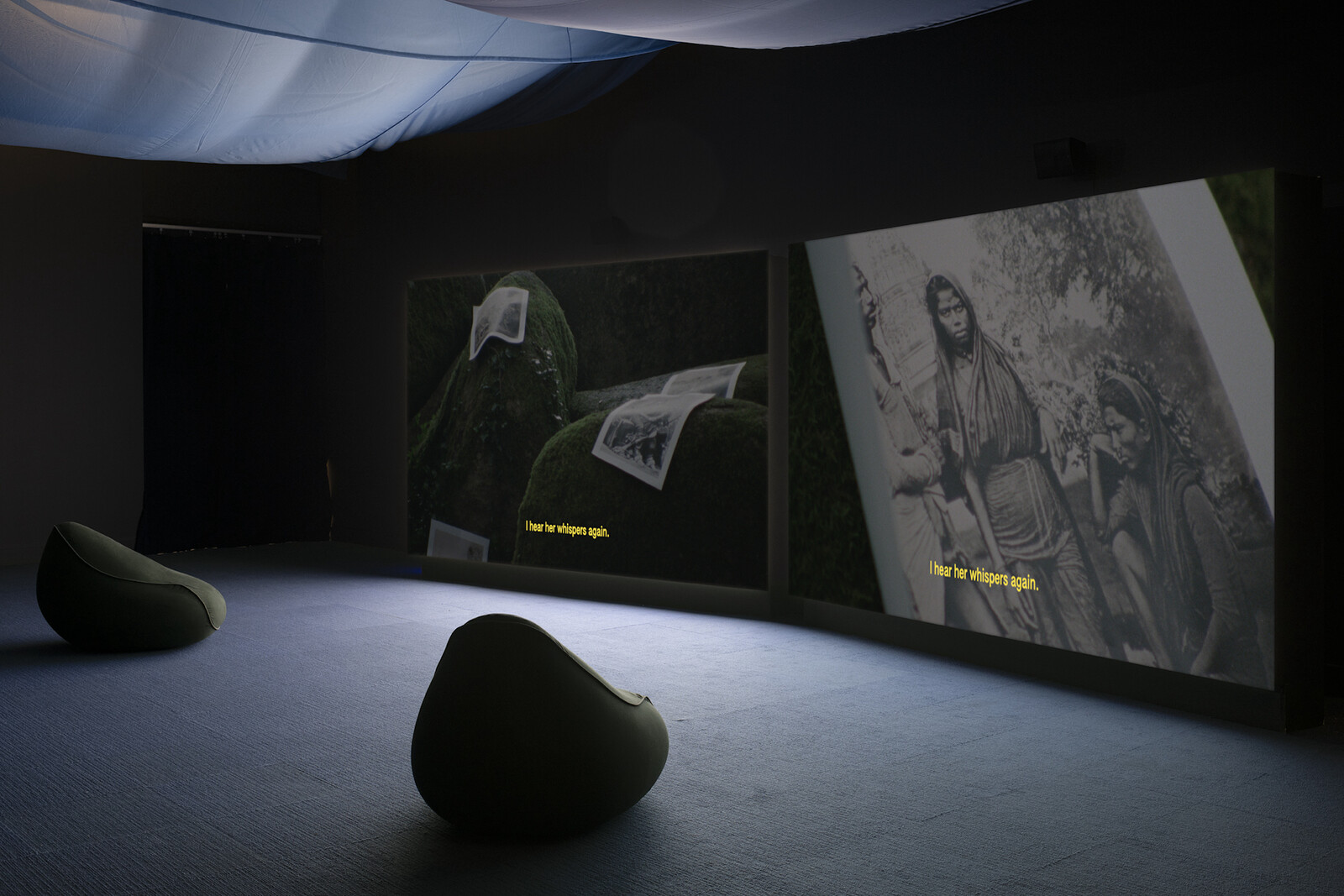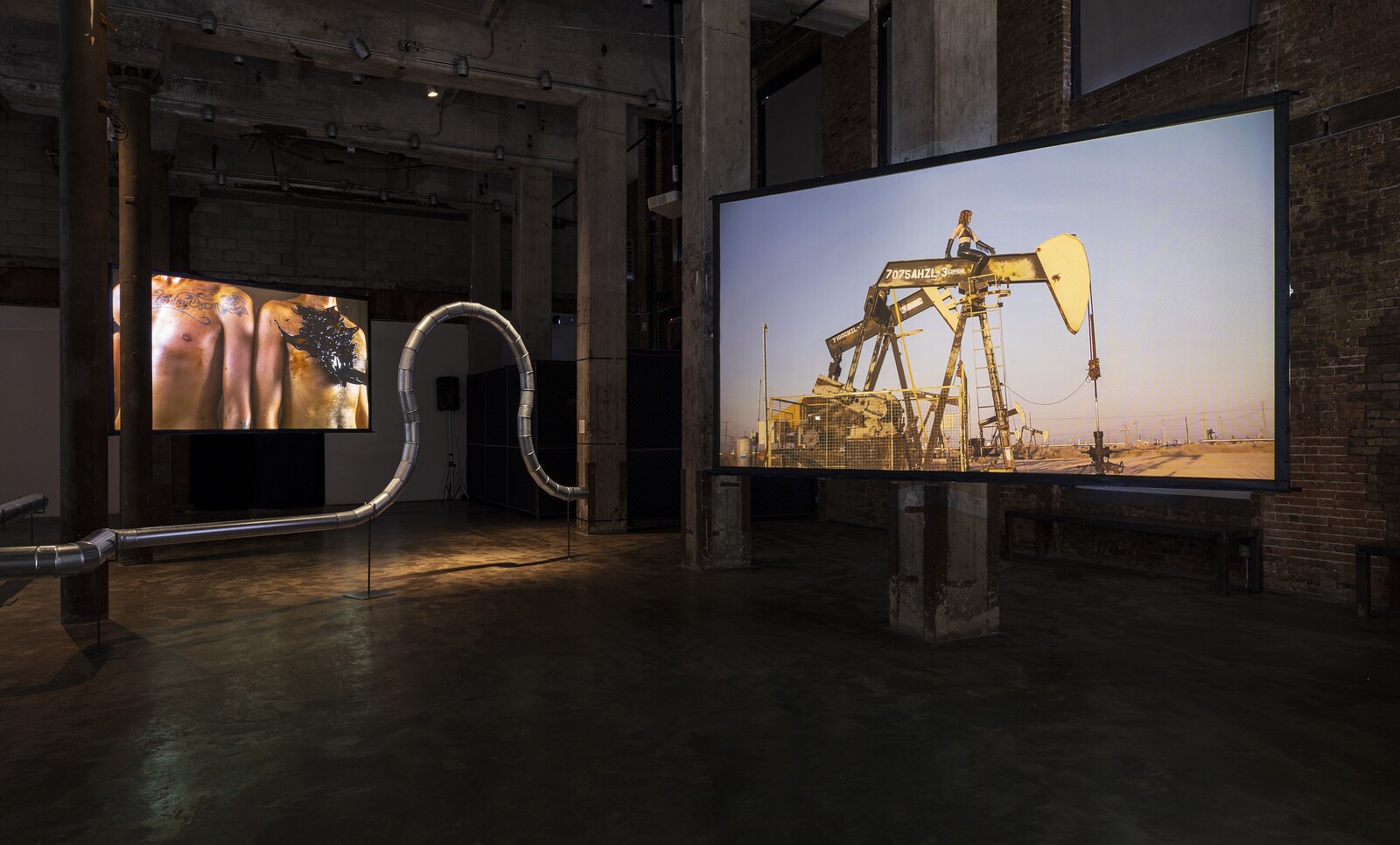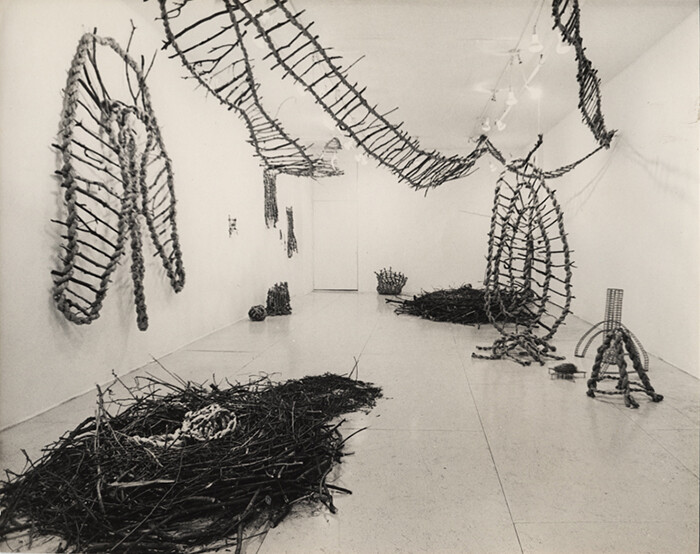Categories
Subjects
Authors
Artists
Venues
Locations
Calendar
Filter
Done
October 15, 2024 – Review
Jenna Bliss’s “Basic Cable”
Chris Murtha

The idea of “Wall Street,” a metonym for global capitalism measured against whatever remains of “Main Street,” has far outgrown its connection to the New York thoroughfare that traces the path of the city’s seventeenth-century border wall. Today, the home of the New York Stock Exchange is heavily secured by bollards, fences, and barricades that regulate and restrict public access. Armed with her camera, native-New Yorker Jenna Bliss roams the narrow canyons of Lower Manhattan. Her unsteady lens lingers on passersby and commercial storefronts; gazes skyward to scale gleaming towers; and hovers, from afar, on the skyline’s iconic, yet ever-morphing silhouette. With the September 11 attacks, the 2008 financial crisis, and the Covid-19 pandemic as inflection points, Bliss blends fact with fiction, past and present, to probe our collective perception of Wall Street as a place and an idea—from the ground up.
To produce the Super 8 films and photographic lightboxes on view at Amant, Bliss splices and recombines her material so that her subjects are neither fully revealed nor entirely obscured, but rather held in disorienting tension. Conspiracy and Spectacle (both 2021 and under two minutes long) loop continuously on box monitors mounted atop tall pedestals arranged to mimic …
February 23, 2024 – Review
Suneil Sanzgiri’s “Here the Earth Grows Gold”
Phil Coldiron

Go past the Tiffany glass, the inventory of deco design and the wing of feminist art that still bears the name Sackler, and finally, tucked away, you’ll find a small enclave of two rooms comprising Suneil Sanzgiri’s solo institutional debut, “Here the Earth Grows Gold.” The smaller of these galleries contains: a sculpture, Red Clay, Stretched Water (Return to the Source) (all works 2023), a kind of provisional hut built of black bamboo and printed images; a minute-long loop of 16mm film, My Memory Is Again in the Way of Your History (After Agha Shahid Ali), in which a digitally-animated banner reading “Your History Gets In The Way Of My Memory” flutters atop waves; and quite a lot of wall text (the one written by the artist himself, demanding that the Brooklyn Museum divest itself of various ill-gotten items in its collection, might reasonably be taken as the show’s fourth work). Moving through a curtain to the centerpiece, the digital double-projection Two Refusals (Would We Recognize Ourselves Unbroken?), maybe the first thing you notice is the gap between its screens: each canted slightly off an unseen wall, they funnel vision to the six inches or so of space between them.
…
December 7, 2023 – Review
Shilpa Gupta
Paul Stephens

Recent New York Times headlines point to American perceptions of India’s increasingly prominent role in global affairs. “Can India Challenge China for Leadership of the ‘Global South’?” “Will This Be the ‘Indian Century’?” “The Illusion of a US-India Partnership.” “US Seeks Closer Ties With India as Tension With China and Russia Builds.” “US Says Indian Official Directed Assassination Plot in New York.” “An Indian Artist Questions Borders and the Limits on Free Speech.”
The last headline refers to Mumbai-based Shilpa Gupta, whose work obliquely explores the emergent global polycrisis (a term popularized by Adam Tooze) in which India plays a central part. Although Gupta’s art is deeply engaged with contemporary political events, it is not headline-driven. It resists didacticism, in part, through being polyvocal, as exemplified in her standout installation Listening Air (2019–23). Defying simple description and rewarding patient immersion, Listening Air consists of multiple microphones-turned-speakers that play songs of labor and resistance from around the world. As the songs fade in and out, listener-viewers in the dimly lit room slowly begin to perceive themselves as members of a temporary community. The effect is ethereal and meditative.
Gupta’s two concurrent New York exhibitions, at Amant and Tanya Bonakdar Gallery, accord …
November 21, 2023 – Review
Jessica Segall’s “Human Energy”
Cassie Packard

Jessica Segall’s transgressive exploration of desire and petroleum unfolds to the beat of a mechanical soundtrack. The work of Berghain resident DJ Steffi, building on Segall’s own recordings of active oil fields, the piston-like pulsations fuse petro-extraction and the nightclub. Desire—for dominion, capital, commodities, relations—has always powered industry; here, industry clearly powers desire, too. Petroleum’s libidinal imaginary encompasses everything from imagery of women virtually fornicating with automobiles to the more abstract seductions of movement, convenience, ease, and accumulation. In Human Energy (2023), a dispersed four-channel video installation with sculptural elements (titled after Chevron’s slogan), Segall renders these fetishizations with erotic effect.
On one channel, the scantily clad, gloved artist climbs and mounts a pumpjack. She rides it as if it were a mechanical bull, moving her hands back and forth to steady herself while the machine repeatedly plunges into the earth. The video was shot in Kern County, California, which is responsible for the vast majority of the state’s oil and fracked gas production and boasts some of the worst air pollution in the country, a burden disproportionately borne by the region’s most vulnerable communities. Panoramic open sky, mountain range, sunset: our petro-cowgirl deploys the tropes that have characterized fantasies …
October 21, 2022 – Review
“SIREN (some poetics)”
Wendy Vogel

Curator Quinn Latimer takes the mythological sirens of the ancient world—“figured as women (part bird or part fish, but all witch)”—as the symbol uniting this group show of seventeen artists at Amant. Such a premise might evoke notions of the demonized, feminized voice: incantations, laughing, shrieks, or related sonic eruptions. Precedents in feminist theory include Silvia Federici’s writing on the etymology of gossip (once defined as a group of women friends); Gloria Anzaldúa’s exhortation that “wild tongues can’t be tamed, they can only be cut out”; and Anne Carson’s assertion that patriarchal culture, from antiquity onward, has enforced “an ideological association of female sound with monstrosity, disorder and death.” However, Latimer (a poet herself) positions the siren’s call as a type of technology that destabilizes binaries—gender and otherwise. The sound of the siren is one of knowledge, seduction, and death that crosses species, bumping against the limits of linguistic order.
The predominant sounds in “SIREN,” therefore, are nonsense and drones—an undoing of language into various states of nonhuman noise. Rather than creating a cacophony, these works are arranged airily throughout Amant’s three discrete spaces (two linked by a café and courtyard, and another across the street), their sound elements sometimes …
October 31, 2017 – Review
Cosey Fanni Tutti
Lucy Reynolds

Cosey Fanni Tutti’s exhibition at Cabinet Gallery is divided into two parts, a photographic exhibition and a film, which together invite the visitor to negotiate not only questions of morality but also archival memento mori. Upon entering the upper gallery, the viewer confronts frames from Cosey’s 1977 photographic collaborations with the American photographer Joseph Szabo, selected from his archive by the artist and retitled Szabo Sessions (2017). Their collaboration plays upon the blurred boundaries between commerce and art, which the artist has confronted through the interposition of her own body in the course of a career stretching back almost half a century.
Szabo’s photographs raise again the uncomfortable questions that Cosey has posed about women artists’ agency to perform and spectacularize their own bodies and their own desire, particularly when that agency touches upon female power as a form of monetary exchange. But Cosey exceeds the neat lineage which a feminist discourse might trace from Hanne Wilke’s S.O.S Starification Object Series photographs (1974-82) or Carolee Schneemann’s Interior Scroll (1975) to the riot grrrl abandonments of Pipilotti Rist or Tracey Emin’s confessional video Why I Never Became A Dancer (1995). Those works signal a critical deployment of the body within the context …
June 8, 2015 – Review
The Gallerist: Kazuko Miyamoto from A.I.R. Gallery and Onetwentyeight, New York
Luca Cerizza

This column aims to introduce and analyze the activity of a number of gallerists and galleries. I am interested in presenting not necessarily the history of major galleries and their successful careers, but to reflect on a series of experimental approaches to the gallery format, and to discuss the different modalities in which the borders of the profession of the gallerist and the format of the commercial gallery have been tested and eventually eroded. The first episode (which discussed Fabio Sargentini and his gallery, L’Attico, in Rome) analyzed the case of a dealer who had a strong curatorial approach to his gallery program and to the exhibition format, to the point of using the gallery as his own linguistic, even artistic, tool. In this second installment, I will discuss the activities of artist Kazuko Miyamoto and her role as an early member of A.I.R. Gallery (Artist In Residence Gallery) and as the founder and director of Gallery Onetwentyeight, both located in New York.
Born in Tokyo in 1942, where she studied art at the Gendai Bijutsu Kenkyujo (Contemporary Art Research Studio), Miyamoto moved to New York in 1964 to attend The Arts Student League of New York, located in Manhattan (1964–1968). …